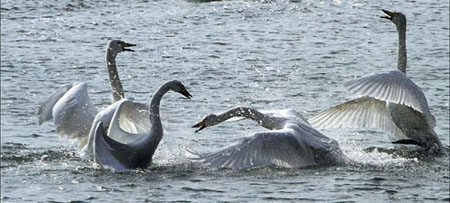
Thousands of swans winter in the coastal wetlands of Shandong each year, and every effort is exercised to make sure these migratory birds have a comfortable refuge. Han Bingbin visits the swan lakes.
Some of China's rare lagoons lie along the relatively unpolluted coastline from Weihai to Rongcheng in Shandong province. Thousands of whooper swans migrate across borders for their annual winter stay here, attracted by the good supply of fresh water and aquatic plants, as well as sparsely populated coastal plains.
These lagoons with their winter population of swans have earned Rongcheng fame as the "home of swans".
An estimated 8,000 swans set up home each year at the wetlands here, for about five months from November to April, after which they fly back to Siberia and Mongolia for the breeding season. In the following years, some of them may make the return journey with their cygnets.
This year, two of the swans that had been previously tagged returned again to Rongcheng, and one has been returning for at least six years.
With encroaching urbanization, there have been tangible fears that the environmentally sensitive birds may face threats to their wintering habitats.
To ensure that the birds will never run short of good fresh water, the local government has embarked on a determined campaign to preserve their quality of life. Landfills nearby were shutdown, and three water-treatment and sewage plants established.
The attention to details has been extended even to controlling the amount of dust in the air, and unsurfaced mud tracks have been resurfaced.
In addition, a group of cleaners is employed to make sure that litter and waste left by sightseers are disposed of, and do not threaten the swans' safety.
High voltage cables that used to entangle and kill the swans in flight are now buried underground. The government even promises to compensate villagers whose wheats are eaten by the swans.
In fact, everything that can be done has been done to make sure the swans are safe, settled and happy.
To facilitate that industry, a dam was built at the harbor entrance. Since then, tidal water has been greatly reduced and as a result, much sludge began to form. Seaweed and seashells were the first casualties.
The situation is such that the swans are now fed tons of bird feed every year, instead of foraging for themselves. Experts say the worst scenario is that the lagoons will dry up and the swans will disappear.
In its tough battle against ecological degradation, the local government launched a remedial project worth more than 60 million yuan ($9.65 million) in 2011. One of the first projects was to demolish the harbor front dam and to dredge off the sludge that had accumulated.
The project will clear sludge in a 400,000-square-meter area that will make room for the eel grass to grow again.
Supported by the Ocean University of China's artificial planting technologies, the Rongcheng government has sown about 50 kilograms of eel grass seeds and put in another 1,000 kg of baby clams to kick start the ecological transformation.
Once the habitats of the eel grass and clams are established, conservationists can reduce the amount of bird feed by at least 10 tons, starting from this year.
Fish-farming, the main source of income for residents of the area, will also be severely restricted in certain stretches.
